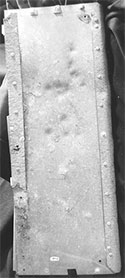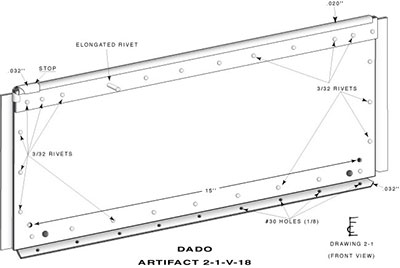 |
|
|
|
|
|
|
|
|
|
|
|
||
|
|
|
||
October, 1996
| [L10] Dado (TIGHAR Artifact 2-18) | ||
| Date Found: | October 1989 during TIGHAR’s NIKU I expedition. |  |
| Materials analysis: | NTSB | |
| Report date: | March 5, 1992 | |
| Description: | This aluminum sheet metal assembly is made up of at least four separate components, a wide web (0.032 inch thick), a narrow flat strip (0.022 inch thick), a 180 degree flange (0.022 inch thick), and a 90 degree flange 0.022 inch thick. Overall, the assembly is 16.75 inches long by 6.5 inches wide. All four edges of the web appear to be manufacturer’s cuts with 3/32 inch diameter rivet holes and remnants of rivets nearby. The 90 degree flange is attached to one long edge of the web by rivets spaced 1.75 inches apart. The 180 degree flange and the flat strip were riveted to opposite sides of the other long edge of the web. | |
| Condition: | Corrosion of the assembly components is heavy with the areas of the 180 degree flange and flat strip showing perforations. The space between the flange, web, and strip was filled with what the NTSB judged to be corrosion products but TIGHAR researcher Frank Lombardo has performed a more detailed inspection and believes that these “corrosion products” are, in fact, remnants of micarda stripping installed to inhibit corrosion. A long rivet tail is located in the area of severe corrosion. During optical examination, the NTSB noted small remnants of a bluish woven fabric around the rivet tail. | |
| Identification: | This type of assembly, known as a dado, was used in the interior finishing of small cabin-class airplanes to protect the juncture between the cabin wall and floor. Although we have the complete assembly, there is no part number as is found on military fixtures (for example, the Navigator’s Bookcase) Military aircraft do not normally carry this type of interior furnishing. | |
| Commentary: | Because they are interior furnishings rather than structural components, dados can vary greatly depending upon the cabin configuration of the particular aircraft. The available plans for the Lockheed Model 10 are for the airline version and include structures similar, but not identical, to the object found on Nikumaroro. No plans or photographs of the final configuration of the cabin of Earhart’s airplane are known to exist. There are, however, several interesting observations which can be made about the artifact. As shown in the reconstruction below, the mounting holes by which
the dado was affixed to the aircraft structure are exactly 15 inches
apart. The Lockheed Model 10 fuselage is built on a 15 inch standard,
with bulkheads, circumferentials and stiffeners spaced, on the average,
15 inches apart. Specifications for the Lockheed Model 10 call for the cabin area to be insulated with .25 inch kapok. The insulation, known by the trade name “Seapak”, was a fabric-kapok-fabric sandwich. One of the standard fabric colors was blue. The 90 degree flange along the base of the dado was attached to the aircraft floor with screws in metal-floored aircraft or nails in airplanes with wooden flooring. On the artifact, pry marks on the underside of the flange at the holes indicate that, in this case, nails were probably used. The floor of the Lockheed 10 was made of wood. |
|


